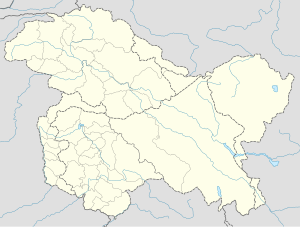The Battle of Shalateng[2] was a military engagement on 7 November 1947, during the Indo-Pakistani war of 1947–1948. It was a decisive battle that resulted in the halting of the Pakistani offensive and the beginning of the Indian counter offensive.[3]
| Battle of Shalateng | |||||||
|---|---|---|---|---|---|---|---|
| Part of the Indo-Pakistani war of 1947–1948 | |||||||
| |||||||
| Belligerents | |||||||
|
|
| ||||||
| Commanders and leaders | |||||||
|
|
| ||||||
| Units involved | |||||||
|
| ||||||
| Strength | |||||||
| ≈ 3,400 soldiers (4 regiments) | ≈ 1,000 | ||||||
Build-up
editThe Battle of Badgam had taken place just 4 days earlier, in which the advance of Tribal lashkars of Pakistan was halted and the Srinagar airport was secured, allowing more forces to be flown in.[3]
On 6 November, an aerial patrol observed a significant gathering of tribesmen in the Zainakot area near Shalateng village, facing the defences of 1 Sikh on the outskirts of Srinagar town. This group was observed engaging in digging activities, signalling preparations for an imminent assault on the town.[3]
The plan was to encircle them through a flanking maneuver led by 1 Kumaon (Para) on the southern side of the Sikhs, and 4 Kumaon on the right flank. Early morning on 7 November, a squadron of four Daimler armoured cars of 7 Light Cavalry was inducted.[4] Two armoured cars were deployed in support of 1 Sikh, and two were sent to reconnoitre, and positioned themselves behind the tribal lashkar forces.[5]
The battle
editOnce the tribesmen were surrounded, the Indian forces opened up and strafing air support was also provided by Spitfires of the Airforce. The tribesmen were taken by surprise and broke ranks and fled, leaving over 600 dead and much of their arms, ammunition and equipment.[5][6]
Aftermath
editThe Pakistani raiders fled with the Indian Army in hot pursuit. By evening, 1 Sikh had recaptured Pattan, and at around midnight, 1 Kumaon (Para) along with the armoured cars and a troop of 25 pounder guns advanced towards Baramulla, which was occupied by 5.30 pm on 8 November.[5] By 13 November, territory up to Uri was recaptured and Kashmir Valley was brought firmly in India's control.[3][6]
See also
editReferences
edit- ^ Whitehead, A Mission in Kashmir 2007, pp. 159–160.
- ^ "shalateng: 75 years of 'Battle of Shalateng' - most decisive battle of first Indo-Pak war". The Economic Times. Retrieved 2024-03-30.
- ^ a b c d "75 years of 'Battle of Shalateng' - most decisive battle of first Indo-Pak war". Economic Times. 7 November 2022.
- ^ "A giant leap that saved Srinagar in 1947". The Tribune. 14 December 2019.
- ^ a b c Kuldip Singh Bajwa (2003). Jammu and Kashmir War, 1947-1948. Har-Anand Publications. p. 132. ISBN 9788124109236.
- ^ a b "Guts and glory: Decisive wars that India won". India Today. 19 January 2023.
Works cited
edit- Whitehead, Andrew (2007), A Mission in Kashmir, Penguin, ISBN 978-0-670-08127-1
